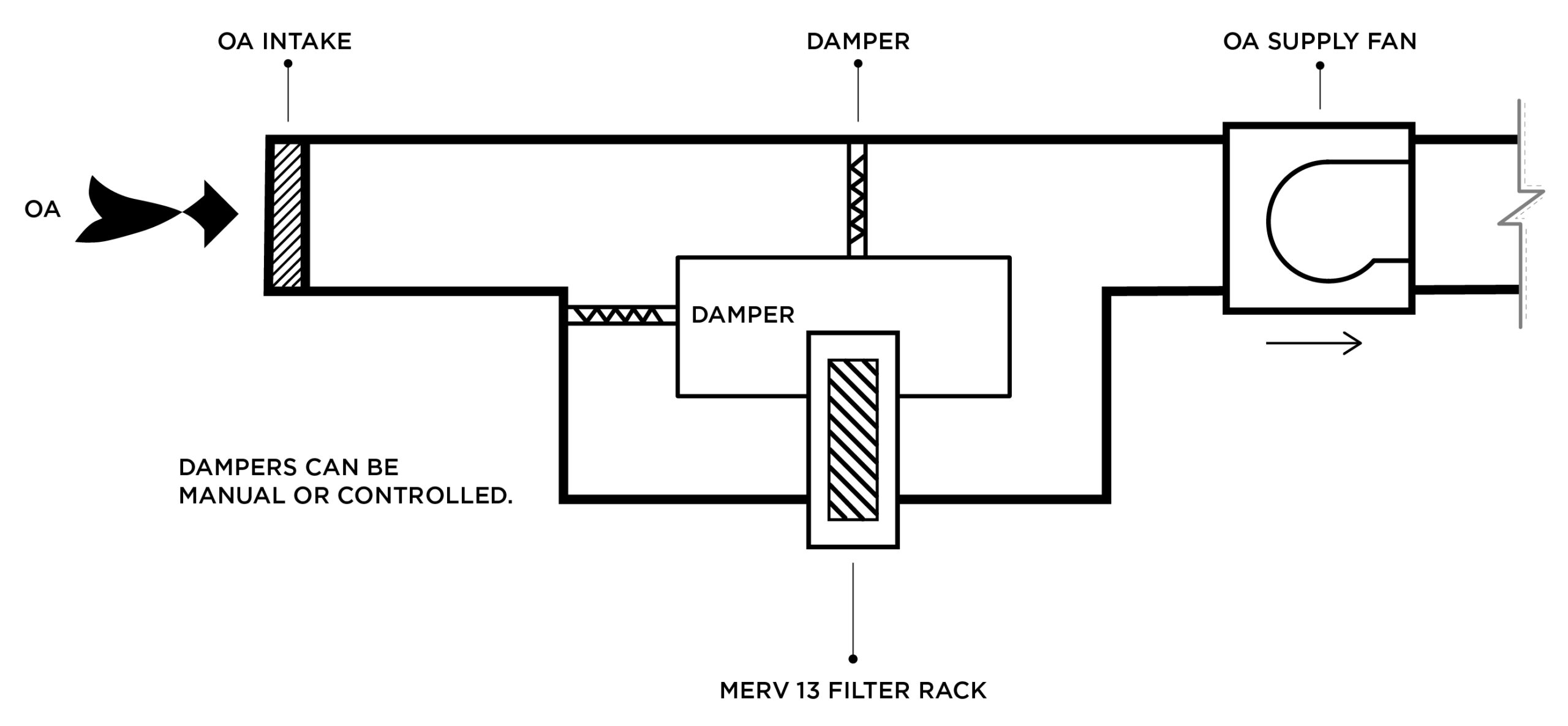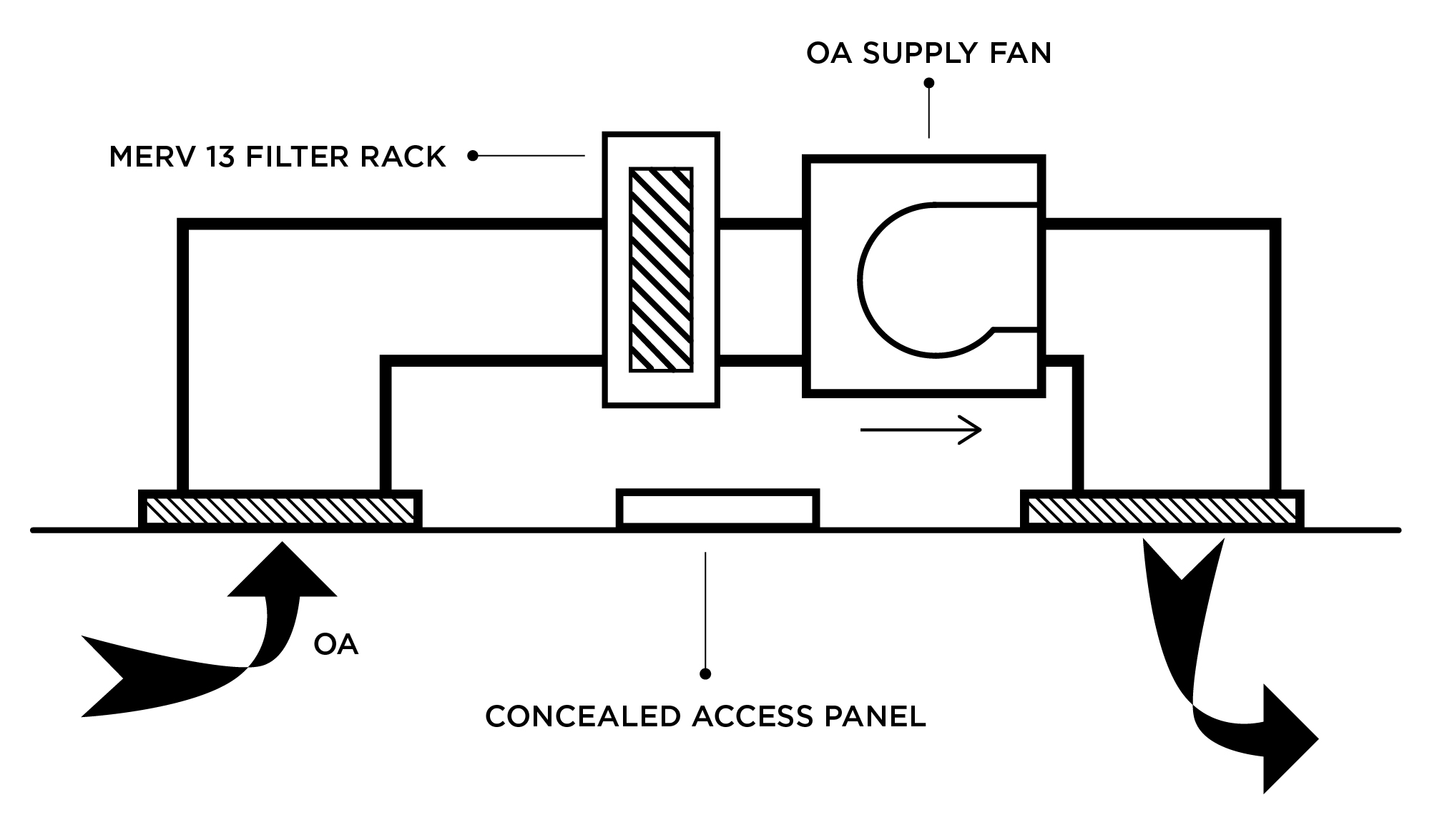According to the United States Environmental Protection Agency (EPA), the U.S. experiences an average of 70,000 wildfires every year. The fires and ensuing clouds of smoke present a challenge to the safety and well-being of building occupants.
This guide highlights multiple strategies for limiting wildfire smoke from entering into buildings. These recommendations are based on decades of fire and life safety experience acquired by Henderson Engineers while servicing a variety of industries including healthcare, federal government, high rise, assembly, collegiate, retail, residential, sports, and commercial projects. Each strategy should be evaluated against the specific site and budget conditions.
Planning Strategies
- Conduct an assessment to determine if the site is at risk for local wildfire smoke. We recommend using the interactive map linked below to investigate where recent wildfires have occurred.
- Create a mitigation plan with a trusted consultant by discussing which strategies presented within this guide make sense for your site and budget.
Architectural Strategies
- Seal the architectural envelope. A tight envelope will help prevent smoke from infiltrating into the building. Areas to focus on when sealing the envelope include:
- Wall penetrations (windows, louvers, etc.).
- Roof penetrations (curbs, skylights, etc.).
- Doors that are equipped with sweeps and stripping.
- Consider installing vestibules or rotating doors, which add an additional buffer zone of airspace between the building and the outdoors to prevent smoke infiltration. These types of doors also help with preventing stack effect on tall buildings and/or may be required by local code.
- Conduct pressure tests during non-fire event times to identify areas that require additional sealing.
HVAC Strategies
- Install MERV 13 filters standard in HVAC equipment. Henderson finds that MERV 13 filters strike a good balance between increased filtration efficiency and higher pressure drop. A higher pressure drop causes fans to work harder to move air and thus results in slightly higher energy use. Additional considerations regarding MERV 13 filters include:
- Installing air pressure sensors to detect when filters are dirty rather than replacing them on a set schedule. A sensor will help limit excess pressure drop as well as minimize maintenance costs.
-
- Note: During a wildfire situation, these filters will fill up much faster than during standard operation.
- Budgeting for and pre-purchasing multiple filters in advance of fire season to enable multiple changes if necessary.
- When upgrading filters to a higher MERV rating, consult with a trusted consultant to verify the existing HVAC equipment can provide enough pressure to support a MERV 13 filter.
- Buildings that utilize a louver for the outside air intake have a few strategies to consider:
- Install a MERV-13 filter in line with the outside air duct connecting to HVAC equipment – assuming the equipment fan can create enough pressure to accommodate the filter.
- If the equipment fan cannot accommodate the filter, a parallel duct path with control dampers may be added to only route airflow across the MERV-13 filter when temporarily needed. The dampers and filter can be engaged in the event of an ambient indoor air quality (IAQ) problem through controls. However, this option is slightly more expensive due to the additional parts required to make it work.

- An emergency – but still effective – strategy would be to temporarily duct tape MERV 13 filters on the outside air intakes. However, it is preferable to pre-plan for wildfire season using other strategies as much as possible.
Source: Javins, T., Robarge, G., Snyder, E. G., Nilsson, G., & Emmerich, S. J. (2021). Protecting Building Occupants From Smoke During Wildfire and Prescribed Burn Events. ASHRAE Journal.
- Install air curtains above the front doors to mitigate smoke infiltration. This approach is especially effective when the front entrance does not include a vestibule or rotating doors.
- Install smoke scrubbers in duct system. This may be the most expensive measure to consider, but it would effectively treat the incoming supply air.
- Ensure the filter rack inside the HVAC equipment is sealed. The filter cannot do its job if air is leaking by it.
- Install air cleaning devices. There are several air cleaning technologies in the market:
- Electrostatic precipitators are an excellent technology for this application. However, the collection plates will load up quickly during a wildfire event, so maintenance is a consideration.
- Bi-polar ionization (BPI) may also be helpful, but a filter is still required to capture the particles after they stick to ions and become larger in size.
- Ensure the building is positively pressurized, meaning it’s bringing in more outside air than air that is exhausted. This strategy only works if the outside air that is brought in is cleaned and/or filtered to be free from smoke.
- Build a concealed fan and filter system that recirculates air from the space.

Control Strategies
- Disable economizer operation during wildfire events. Limit outdoor air flow to code minimum values to minimize the rate at which the filter is loaded up with smoke particles.
- Install VOC sensors to monitor levels of contaminants in the outdoor air. Many inexpensive indoor air quality (IAQ) sensors are capable of pulling data from nearby weather stations and comparing that data to a target outdoor air quality. When integrated with a building automation system, this control point can be used to engage a smoke control mode in the HVAC system.
- Use the building automation system to provide active pressurization control to ensure the space remains positive. This strategy requires the use of pressurization sensors.
- DO NOT close off outside air completely.
- Shutting off the outside air puts the building at risk of not maintaining positive pressure. The risk of negative pressure may pull in smoky and unconditioned air from the outside.
- In some cases, turning off exhaust would be impossible or put occupants at risk, such as in laboratories or hospitals.
In-Room or Portable Appliance Strategies
Utilize commercial-sized portable air filtration systems. Portable systems provide spot filtration and treatment of local air. This strategy is effective in spaces where the tenant may not have control over the landlord HVAC system.
Calculations / Modeling
Engineers at Henderson have experience helping you decide what is the most appropriate strategy for your situation. Please feel free to reach out to our team if interested in learning more about the listed areas of expertise.

